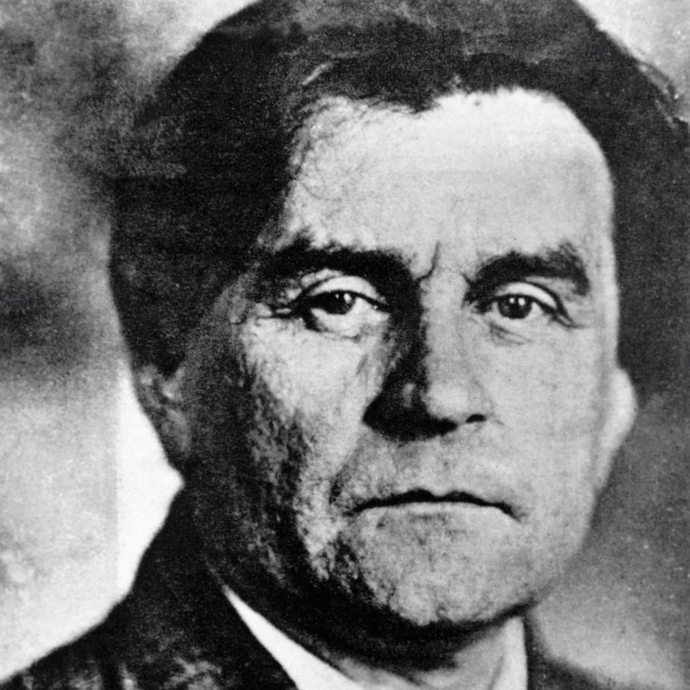
Kazymyr Malevych
Nearly 150 years later, Kazymyr Malevych remains one of the most legendary avant-garde artists. His "Black Square" (which exists in at least 4 different versions) continues to ignite passionate debates about art's essence. Despite being renowned for this minimalist masterpiece — or similarly intricate yet simple "White on White" — he also embraced warm, vivid colors and shapes with unexpected combinations that mirror the puzzle of his life.
Biography of Kazymyr Malevych
One aspect of Kazymyr Malevych that is often misunderstood is his origins. Despite being celebrated worldwide as a Russian artist, he was actually of Ukrainian descent and born in Kyiv in 1879 to a Polish Catholic family of Severyn and Liudvika Malevych.
Malevych spent the first 18 years of his life in Ukraine, traveling throughout the country and residing mostly in small towns. These experiences exposed Malevych to traditional Ukrainian art, crafts, and folklore, which he later reimagined in a bold, yet distinctively recognizable manner. The countryside had a profound influence on him — he even attempted to recreate the wall paintings from village houses, particularly those depicting furnaces, back at home, being scolded for that.
Malevych's father worked as an engineer in sugar production, leading the family to travel frequently. It was expected that Malevych would follow a similar path. However, encouraged by his mother, who helped him conceal his passion for art from his disapproving father, he chose to pursue painting instead.
Malevych's first steps in this direction were taken at the Kyiv School of Art, an institution founded by Ukrainian artist Mykola Murashko and financially supported by local patron Ivan Tereshchenko. His teacher at the school was the internationally celebrated Ukrainian artist Mykola Pymonenko, known for his prominence in his era. Malevych studied at the Kyiv Art School from 1895 to 1897.
In 1904, Malevych relocated to Moscow, where he honed his skills at the School of Painting, Sculpture, and Architecture from 1904 to 1905. He further developed his craft in the studio of F. Roerberg from 1905 to 1910.
From 1919 to 1922, Malevych taught at the Vitebsk Art School, and from 1923 to 1927, he served as the director of the Institute of Artistic Culture in Leningrad (now Saint Petersburg). The artist returned to Kyiv in 1927 due to increasing pressure from the authorities. He spent three more years in Ukraine, teaching at the Kyiv Institute of Art and contributing to the Kharkiv magazine “New Generation” — an iconic suprematist publication. However, Malevych was compelled to leave the country once again because of the escalating repressions of the Soviet government against Ukraine.
Malevych's intention to relocate to Europe was serious and long-term. In preparation for this move, he took his entire archive, accumulated by March 1927, without sorting or selecting items. This archive of Malevych's works is currently housed in Berlin, Germany. Notably, Malevych left a widely known note attached to the Berlin archive capsule, stating, "In case of my death or hopeless imprisonment..." This note suggests that the intuitive Malevych was acutely aware of the potential dangers that awaited him in the USSR.
Despite contemplating starting a new life in Europe, where he was highly respected, Malevych remained under the scrutiny of the Soviet secret services. The regime tolerated him due to his international fame, but the rising dominance of "socialist realism" — a style Malevych despised — left no room for avant-garde art, which was deemed bourgeois.
Malevych had plans to move to Kyiv in 1930, but upon returning to Leningrad where his family resided, he was unexpectedly arrested. In the autumn of 1930, he was accused of being a Polish spy and interrogated by the NKVD with the possibility of execution. He endured three months of imprisonment.
The years 1932-33 marked the peak of the Soviet government's repressions in Ukraine with the Holodomor, one of the most tragic episodes of mass famine, orchestrated by the central government in Moscow. What remained particularly tragic was the extensive censorship surrounding this topic. Malevych, however, was one of the few Ukrainian artists who dared to reflect this horror in his paintings. Many pieces from his "peasant" series contain subtle references to the tragedy, such as handless and faceless depictions of Ukrainian peasants. Interestingly, many paintings addressing this sensitive topic were intentionally dated incorrectly, often with an earlier date, to avoid repercussions for this artistic protest.
The artist passed away in 1935 in Leningrad and was buried near Moscow. Unfortunately, during the Second World War, the exact location of his burial site was lost. It was later rediscovered by a group of activists. In 1988, a memorial sign in honor of Kazymyr Malevych was erected nearby, approximately two kilometers from the actual burial place. However, in 2013, a residential building of the Romashkovo-2 complex was constructed in the precise location where Kazymyr Malevych's ashes were originally interred.
Kazymyr Malevych's Art Style
In his early works, Kazymyr Malevych combined elements of cubism, futurism, and expressionism — sometimes describing the style as cubofuturist. This artistic approach brought him close to many other artists, including Ukrainians Volodymyr and Davyd Burliuk.
The true inner discovery for Malevych occurred in 1915 when he founded a new modernist movement Suprematism. Describing it as the ultimate separation between art and the portrayal of the real world, he emphasized that all focus should be on color, form, and texture. According to Malevych, we can only perceive the true essence of an artwork when we cease trying to see fragments of reality within it.
Malevych indeed elevated the square to a regal status by exhibiting the yet unfinished "Black Square" at The Last Futurist Exhibition of Paintings 0,10. Intriguingly, among the 39 pieces presented at the exhibition, the "Black Square" was positioned in a place traditionally reserved for holy icons. Over time, it became an icon of the avant-garde movement.
Years:
Born in 1879
Country:
Ukraine, Kyiv